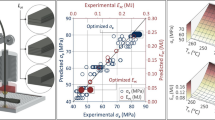Abstract
Thermomechanical analysis (TMA) results indicate that simple post-treatment (such as some postcuring) conditions capable of improving the mechanical performance of aminoplastic resins-bonded particleboard without any degradation do indeed exist. A model to describe the decrease in temperature under different conditions of a particleboard after hot pressing has been developed and shown to correlate well with experimental results of board temperature variation after pressing, both on cooling and during postcuring under different conditions. From this, conditions of temperature and time favourable to improve panel performance by postcuring treatments were also determined. The validity of the improvements forecasted under such conditions was then confirmed at molecular level for urea-formaldehyde (UF) adhesive/wood joints by TMA testing, and finally confirmed by testing the mechanical performance of laboratory UF-bonded boards prepared under the postcuring treatment conditions identified. Noticeable improvements in several UF-bonded board properties such as internal bond (IB) strength, thickness swelling, MOE and MOR were observed by implementing short postcuring periods at temperatures much lower than pressing temperature. The panels performance improvements observed were explained on the basis of the shifts in relative importance of already described and well-known molecular level rearrangements of the cured adhesive network in modern, lower formaldehyde content UF adhesives. The conclusion was that modern, lower formaldehyde content UF adhesives can considerably benefit from short, hot postcuring periods as regards board performance, a trend in clear contrast with the degradation and loss of performance this practice was known to induce in the older, very much higher formaldehyde content aminoplastic resins of the past. The coupling of the simple and very rapid TMA technique with the developed model allows the rapid scan of many other post-treatment schedules and thus to forecast other still possible improvements in the performance of UF-bonded and other-adhesives-bonded particleboard.
Zusammenfassung
Ergebnisse der TMA zeigen, daß es tatsächlich einfache Bedingungen zum Nachhärten von Spanplatten gibt, womit die mechanischen Eigenschaften von Aminoplastgebundenen Platten ohne Abbauerscheinungen verbessert werden können. Es wurde ein Modell entwickelt, das den Temperaturverlauf in Spanplatten unter verschiedenen Bedingungen nach dem Heißpressen beschreibt. Das Modell korreliert gut mit experimentellen Temperaturmessungen nach dem Pressen, und zwar sowohl während des Abkühlens als auch beim Nachhärten unter verschiedenen Bedingungen. Daraus wurden günstige Temperatur- und Zeitbedingungen abgeleitet. Die Gültigkeit der vorhergesagten Verbesserungen wurde zunächst auf molekularem Niveau an Holz/Leim-Verbindungen (UF-Harz) überprüft, und schließlich durch mechanische Tests an Laborspanplatten, die unter den entsprechenden Bedingungen hergestellt wurden, bestätigt. Merkliche Verbesserungen einiger Eigenschaften von UF-gebundenen Spanplatten (wie Querzugfestigkeit, Dickenquellung, MOE und MOR) ergaben sich bei kurzen Nachhärtzeiten und Temperaturen weit unterhalb der Preßtemperatur. Die Verbesserung der Leistungsfähigkeit der Platten wird erklärt durch bereits beschriebene und wohlbekannte molekulare Umlagerungen des Netzwerks der ausgehärteten modernen UF-Harze mit niedrigem Formaldehydgehalt. Die Schlußfolgerung ist, daß die Leistung moderner UF-Harze mit niedrigem Formaldehydgehalt beträchtlich gesteigert werden kann durch kurze Nachhärtezeiten bei hohen Temperaturen. Dies steht im deutlichen Gegensatz zu früheren Konzepten bei Verwendung älterer Aminoplaste mit hohem Formaldehydgehalt; denn dabei mußte mit Abbau und Qualitätsverlusten gerechnet werden. Die Kombination der einfachen und rasch durchzuführenden TMA mit einem Simulationsmodell ermöglicht eine rasche Beurteilung verschiedener Nachbehandlungs-Fahrpläne und somit die Voraussage weiterer möglicher Qualitätssteigerungen von UF-gebundenen Spanplatten.
Similar content being viewed by others
References
Garcia R, Pizzi A (1997a) Cross-linked and entanglement networks in thermomechanical analysis of polycondensation resins,. Appl. Polymer Sci., in press
Garcia R, Pizzi A (1997b) Cross-linked and entanglement networks in thermomechanical analysis of polycondensation resins, Proceedings of the 18th Research Group on Wood Adhesion symposium. Japan Wood Research Society, October 30–31, pp. 19– 35
Humphry PE, Bolton AJ (1989) The hot pressing of dry-formed wood-based composites. Holzforschung 43(3) 199–206
Kamoun C, Pizzi A, Garcia R (1998) The effect of humidity on cross-linked and entanglement networking of formaldehyde-based wood adhesives. Holz Roh- Werkstoff. 56: 235–243
Kollman FPF, Côté WA (1968) Principles of wood science and technology, Vol. 2, Springer Verlag, Berlin
Lu X, Pizzi A (1998) Curing conditions effects on the characteristics of thermosetting adhesives-bonded wood joints — Part 1, Holz Roh Werkstoff 56: 339–346
Meyer B (1979) Urea-formaldehyde resins, Addison-Wesley, Reading, Massachusetts
Pizzi A (1983) Aminoplastic wood adhesives, chapter 2 in Wood adhesives chemistry and technology (A. Pizzi Ed.), Marcel Dekker, New York
Pizzi A (1997) On the correlation of some theoretical and experimental parameters in polycondensation cross-linked network. J. Appl. Polymer Sei. 63: 603–617
Pizzi A, Lu X, Garcia R (1997) Lignocellulosic substrates influence on TTT and CHT curing diagrams of polycondensation resins. J. Appl. Polymer Sci. in press
Pizzi A, Probst F, Deglise X (1997) Molecular mechanics modelling of interfacial energy and flexibility. Adhesion Sei. Tech-nol. 11(4): 573–590
Probst F, Laborie M-P, Pizzi A, Merlin A, Deglise X (1997) Molecular mechanics/experimental methods applied to varnish/ primer/wood interactions. Holzforschung 51: 459–466
Author information
Authors and Affiliations
Rights and permissions
About this article
Cite this article
Lu, X., Pizzi, A. Curing conditions effects on the characteristics of thermosetting adhesives-bonded wood joints. Holz als Roh- und Werkstoff 56, 393–401 (1998). https://doi.org/10.1007/s001070050339
Issue Date:
DOI: https://doi.org/10.1007/s001070050339




